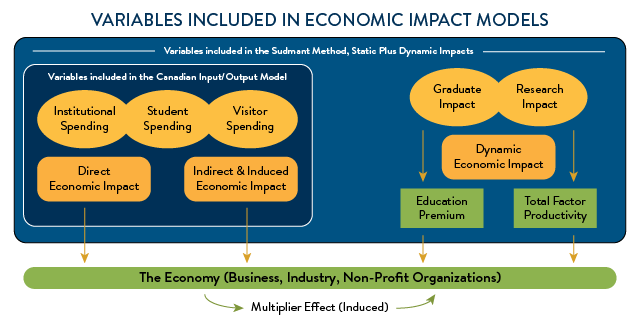How We Calculated
There are many different ways to calculate a total economic impact. Two were chosen: The Sudmant Method, and the Canadian I/O Model. Both are widely used by other universities to estimate economic impact, which lets us compare Brandon University to other institutions.
The Canadian I/O Model estimates the impact Brandon University has in three specific areas:
- BU institutional spending: Direct impacts of Brandon University spending on operations and capital expenditures;
- Student and visitor spending: Direct impacts of the spending of students as well as visitors who come to the region for day trips or overnight trips as a result of the University educational, arts or sporting events; and
- Multiplier effect: Indirect and induced impacts created by having the University located in Brandon (impacts that would not otherwise occur if Brandon University did not exist).
The Sudmant Method includes those three, as well as two more:
- Alumni education premium: The positive effect of alumni staying in the region; and
- Research value: The impact of new knowledge created by Brandon University’s faculty and research institutes.
Only the University’s own expenditures are directly measurable, other items are estimated as best as possible, using industry standard methods.

Variables used in the Sudmant Method and the Canadian Input/Output Model (Adapted from University of Calgary, 2013)
Sudmant Method
The Sudmant Method recognizes a university has both a “static” impact and a “dynamic” impact on a region’s economy. A static impact measures the economic impact at a specific point in time, whereas a dynamic impact refers to ongoing economic impacts.
This “new generation” model improves upon prior models by including the dynamic economic impacts of a university’s research as well as the annual contribution of all alumni currently employed in the region.
The Sudmant Method was first used in relation to university economic impact analysis for the University of British Columbia in 2009. Since that time, many universities have used it for their impact analysis.
The Sudmant Method incorporates the effects of direct, induced, and dynamic economic impacts within five categories:
- Institutional Spending includes Operations and Capital Expenditures. Operational Expenses comprise faculty/staff compensation, student scholarships, bursaries and awards, materials, supplies and services; Capital Expenditures include building upgrades and infrastructure, research, equipment and library acquisitions;
- Student Spending includes all full-time local and non-local students. This method rationalizes if these students left the city to study elsewhere, there would be a loss of this spending in the city. International students are also included in this calculation;
- Visitor Spending includes visitors coming to Brandon University events – both academic and non-academic (e.g., sporting events, tournaments, music recitals and theatre productions, and student and staff visitors (i.e., family, friends and colleagues);
- Alumni Education Premium is a measure of the impact of Brandon University’s alumni base in the workforce. This number includes all graduates currently working in the region (ages 25-65) and compares the difference in earnings of an individual with a degree versus those who do not hold a degree. Calculations are typically determined for a single year; and
- Research Impact estimates the impact of the university’s research and research products, and innovation in the local economy, for example human capital developed by the university, research by faculty and graduate students and consulting services offered by the faculty.
Canadian Input/Output Model
The second economic assessment method uses the Canadian I/O Model (Statistics Canada, 2009). It is a reliable economic impact method with a long history in economics, dating back to work in the 1950s and it has also been used to assess the economic impact of universities in Canada.
This model can estimate economic impacts at interprovincial and national levels, and uses industry averages as multipliers, to estimate the added value that an industry brings as their initial dollars are re-spent through the economy.
There are challenges in applying this model to a university. Multiplier values are not current (the most recent are from 2010) and converting a university’s impact to strictly monetary terms ignores the important social and cultural impact.
BU’s local economic impact was calculated by estimating total spending in Brandon and using provincial multipliers as a proxy. The university’s spending on operations, capital expenditures, student spending and visitor spending can be summed into a total impact and illustrates an economic impact in the following areas:
- Total Gross Output is the total gross revenue from the sale of goods and services by a business. This is the broadest measure of economic activity and indicates the total sales and transactions triggered by operations.
- Total Gross Domestic Product (GDP) Basic Price or “Value Added” to the economy refers to the unduplicated total value of goods and services. It refers to the sum of its factor incomes (wages and salaries, supplementary labour income, mixed income and other operating surplus) plus indirect taxes on production less subsidies on production. The outcome is Total GDP Basic Price.
- Total Labour Income is the total value of wages and salaries associated with the employment impact.
- Total Jobs resulting from Brandon University’s existence i.e., direct, indirect and induced.
- Total Indirect Taxes refers to the total amount of revenues generated by the economic activity for different levels of government; in this study general indirect taxes are calculated.
